With the response I had to last week’s Tempting Tuesday about the Certosa di San Giacomo in Capri, I’ve learned I’m not the only one who enjoys a beautiful chiostro, or cloister. I promised another treat, and this week we’re going on a walk around the small, but spectacular Cloister of Paradise at the Duomo of Amalfi. Built between 1266 and 1268, this cloister is only one of the many reasons you need to be sure to explore the Duomo when you visit Amalfi. While the word “paradise” could certainly describe the unreal beauty of the cloister, the name instead reflects the original function of the space. In the 13th century, this was the cemetery for the noble merchants of Amalfi.
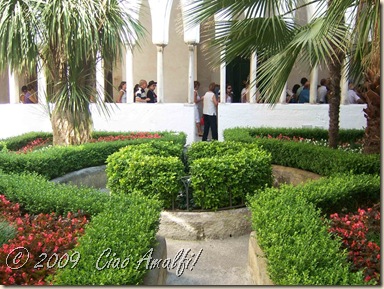
Walking around the cloister, you can admire the Moorish style interlaced arches, supported by 120 slender columns. The whitewashed walls intensify the vivid colors of the small Mediterranean garden in the center of the cloister. On the northern side of the cloister, be sure to stop and admire the perfectly framed view of the Duomo’s campanile, completed in 1276.
For those of you that really enjoy architecture, check out the cutaway plan for the Duomo of Amalfi below. (Click on the image to make it larger.) There you can see the location of the Cloister of Paradise in the lower left hand corner, and how it is connected to the rest of the Duomo complex.
Surrounding the cloister are several works of art that are worth stopping for a closer look. Here you can see the remains of a Byzantine period pulpit from the Duomo (dating from 1174 – 1202), featuring inlaid mosaics of the Cosmatesque school. On the Amalfi Coast, you can find several excellent examples of these types of pulpits intact in the Duomo of Amalfi, but also the Duomo of Ravello, Duomo of Scala, and particularly fine pieces in the Duomo of Salerno. I’m not sure the story behind why this exact piece didn’t survive, but there certainly must be a story there!
Also around the cloister you will find several sarcophagi, including two fine examples dating from the first half of the 2nd century. The sarcophagus in the photo below shows a scene from Greek myth of “The Rape of Persephone.”
Around on the other side of the cloister there are small chapels filled with frescoes from the 14th century. The fresco pictured bellow is similar in style to the Giotto School, and has been attributed to Roberto d’Oderisio, one of the most important painters in the region of Campania in latter half of the 14th century. In the foreground of this Crucifixion scene, you can see Christ on the right, with the suffering Virgin Mary in the center with John and Mary Magdalene.
For more photos of the cloister and the Duomo of Amalfi, be sure to visit the Amalfi Cathedral page on Sacred Destinations. And while you’re there, travel around and see other Sacred Sites in Italy.
Details
Visiting the Duomo is free, but to see the Cloister of Paradise and the museum you will have to pay €2.50. An excellent brochure is provided in several languages, and gives you all the information you’ll need for an informative and pleasant visit. Your walk begins in the Cloister of Paradise, continues in the museum, takes you down to the impressive crypt of Sant’Andrea, and then finally leads up to the central nave of the Cathedral. For about the cost of one gelato, I guarantee you won’t be disappointed! You can enjoy your gelato after on the grand staircase of the Duomo overlooking Amalfi’s main piazza. The great people watching is free!
Related Posts
Tempting Tuesday: The Certosa di San Giacomo in Capri
Tempting Tuesday: Summer Boats on the Amalfi Coast
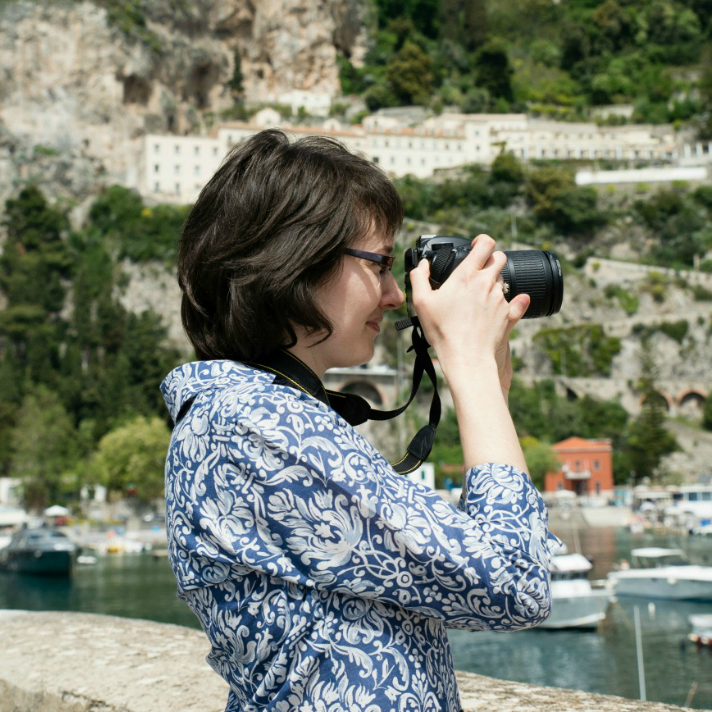
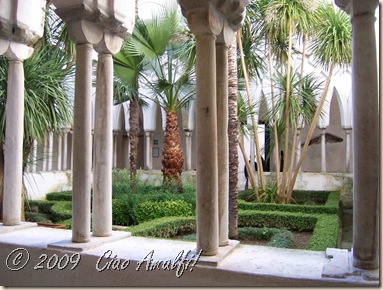
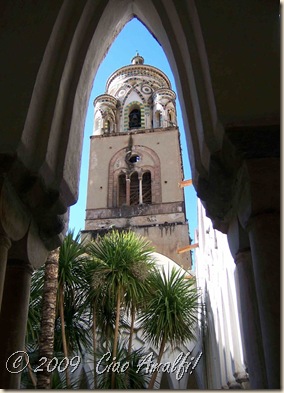
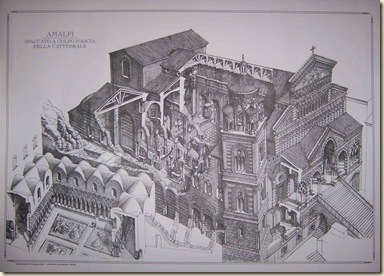

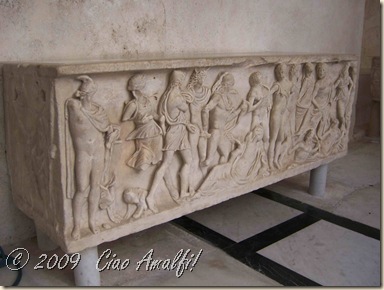
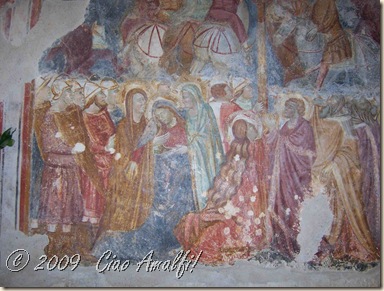


"For those of you that really enjoy architecture"- that really made me laugh because I LOVE axiometric views. I could stare at them for hours. The one you posted is a really good one.
The pulpit in Sessa's cathedral bears some similarities to that pulpit group (though its defining characteristics make it quite different imo), esp. the figurative mosaics.
The photos once again take me there! I love the arches!! I will study the Duomo. The Islamic architecture is phenomenal! You explain and show this beautiful ancient work as an historian. Thank you 🙂
Ciao KC! I thought of you when I posted that axiometric view of the Duomo. And you even know the fancy name! 🙂 I have stared at that one for hours. It is rather large, and I had it above my desk while I was working on my thesis. Actually, I don't want to think about how many hours I spent looking at it! 🙂
Have you posted pictures of the pulpit in Sessa's cathedral? I don't know much about the pulpits here on the Amalfi Coast, but I would love to learn more. Maybe we can do an "Invite the Art Historian Over" day here on the blog? 🙂
Ciao Chuck! Glad you enjoyed the photos and post! Where is your family shield inside the Duomo?
Ciao Laura, I believe it is on the first nail head near the alter ! This I am not sure. The crest itself my be bordered with metal. Thank you so much! 🙂
"Paradiso" indeed!
You have to check out the Chiostro in Santa Chiara, Napoli in the future, too. It's just something about these, you know?
Ciao Peter! Oh, yes, the cloister at Santa Chiara is definitely on my must-see list in Naples. Have you seen the Duomo of Amalfi?
Nope! And I'm thinking the same thing about that as I am Caseficio Michelangelo 😀
Ciao Peter! Aha… then you simply must come to Amalfi for a visit! We can brainstorm all kinds of ideas while doing laps around the cloister. 🙂